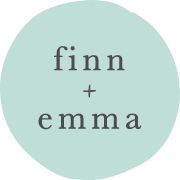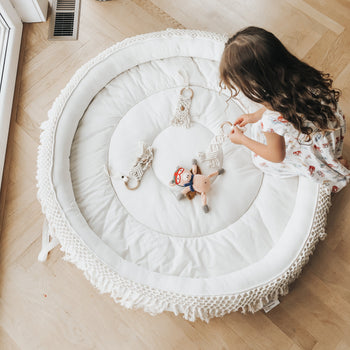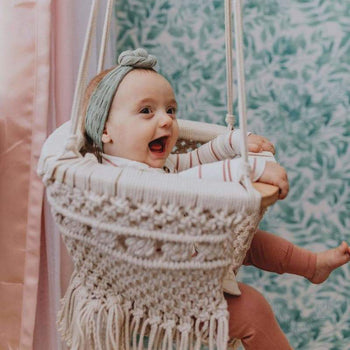Over the past decade, the term “sustainability” has been increasingly used to talk about brands, products, lifestyles, and more. You may be someone who is tuned in to this topic—someone who researches where your food comes from, the values of companies you buy from, etc. And, you might make daily decisions both big and small in ways that align with your own personal values related to the planet and its peoples.
Or, you might not give sustainability much thought in your daily life. You might simply want quality products, good prices, and a pleasant customer experience. It might feel overwhelming to have to think about the environment, climate change, fair wages, and other such topics when you barely have enough hours in the day—and you just need to purchase something for yourself or a loved one ASAP.
If you’re in this second camp—whether you don’t have the time or energy; maybe you dedicate yourself to other sorts of causes; or perhaps you don’t understand what all the sustainable fuss is about—we get it. But we also know that consumers are increasingly curious about sustainable brands, particularly when it comes to clothing. So we’re taking a moment today to dig into this topic.
What exactly is a “sustainable fashion brand”?
The term “sustainable fashion” refers to clothing that is produced and distributed in an environmentally friendly—and often socially responsible—way. In many cases, the clothing is made to last, and a sustainable brand may also have methods by which customers can return used clothing for reuse. In addition to profit, sustainable brands care about people and planet.
What are the main concerns about “non-sustainable” fashion brands?
You might wonder what the big deal is about “non-sustainable” clothing. As noted by the World Economic Forum in 2019, “In the last 15 years the [fashion] industry has doubled production, while the time clothing is worn before it is thrown away has fallen by around 40%.” In other words, more waste; more damage to the environment.
Based on research from The Sustainable Fashion Forum, the fashion industry uses “around 21 trillion gallons of water annually, enough water to fill 37 million Olympic swimming pools.” And, the process of producing a single pair of jeans “takes around 2,000 gallons of water,” not to mention the polluting, energy-intensive dyeing process. “Each year 1.3 trillion gallons of water are used for fabric dyeing alone, contributing to fashion being responsible for up to one-fifth of industrial water pollution, thus making the fashion industry the second largest polluter of clean water globally after agriculture.”
Certain fabrics are a major concern, as well. For instance, polyester, derived from fossil fuels, is most commonly used in fast fashion. And, every time a polyester item is washed “it sheds microplastics (plastic fragments less than 5 mm in length) into our water systems, adding to the plastic levels in our oceans.”
The World Economic Forum report goes on to note that when clothing is thrown away, “73% will be burned or buried in landfill [and] less than 1% of what is collected will be used to make new clothing.”
To learn more, view the full Sustainable Fashion Forum article on “What’s Wrong With Fast Fashion?”
Why support sustainable brands?
Even if sustainability is not a specific or personal priority for you, you might like the idea that your purchase is “doing good.” That by being thoughtful about the clothing you buy for yourself or gift to others, that you are making a small difference. For many customers, that is enough.
For others, buying sustainability allows them to make a statement or start a meaningful conversation with friends and family. At a minimum, well-made items are likely to be useful for longer—which is ultimately a good value even if you’re paying up a little bit at the moment of purchase. Whether you’re buying baby clothes that could be passed down to loved ones in future years, or shopping for a new favorite shirt for yourself, a garment’s long life is a good thing.
Thred Up has a great list of 25 sustainable brands including Patagonia, Reformation, Everlane, Eileen Fisher, and Allbirds. These brands are transparent about their materials and values; many of them are doing very innovative things within their supply chains and companies; and they all care about style and substance.
How does Finn + Emma fit into the sustainability conversation?
At Finn + Emma, all of our clothes are made from 100% organic cotton (certified to meet the Global Organic Textile Standard, “GOTS”) and eco-friendly dyes. On top of that, our garments and accessories are produced in fair-trade settings that focus on social and economic independence for local people—women especially—working to provide for their families in a safe and fair environment.
Here are just a few of the rigorous standards required by GOTS:
Environmental Criteria
- Prohibition of inputs such as toxic heavy metals, formaldehyde, aromatic solvents, and genetically modified organisms
- The use of synthetic sizing agents is restricted
- Bleaches must be based on oxygen (no chlorine bleaching)
- Azo dyes, which release carcinogenic amine compounds, are prohibited
- No PVC, nickel or chrome are permitted on accessories
- Waste water must be treated to make it pollution free
Human Toxicity Criteria
- Raw materials, intermediates, final textile products as well as accessories must meet stringent limits regarding unwanted residues
Social Criteria
- Employment is freely chosen
- Working conditions are safe and hygienic
- Child labor must not be used
- Living wages
And, we love style as much as sustainability. So you can always count on us for fresh colors, modern prints, and a dose of whimsy. Learn more about our values here—and if you have any questions, please let us know!

















